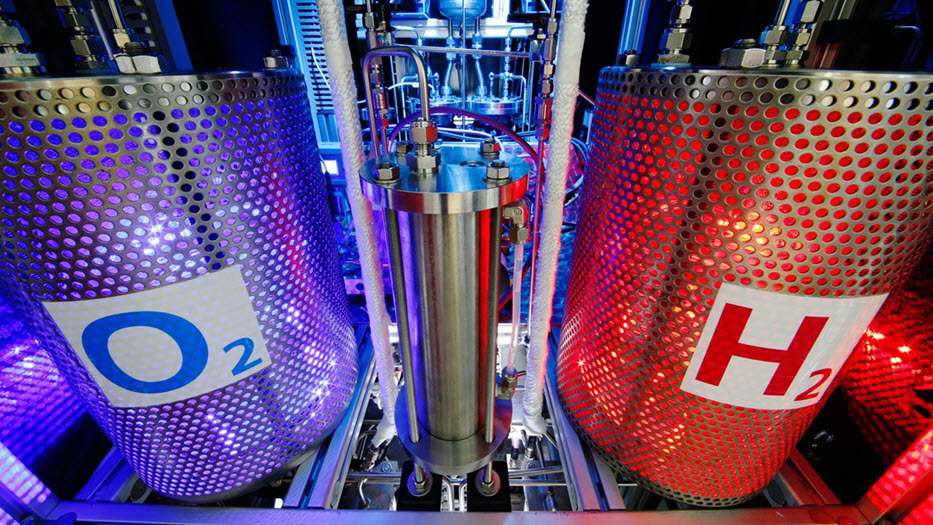
- Green hydrogen economy: sector coupling and international cooperation as success factors
- DLR study examines the potential of green hydrogen as an energy carrier for a climate-neutral energy system.
- Two success factors: consistent sector coupling and international cooperation in production and logistics.
- Germany can take on a global pioneering role in hydrogen technologies and thus strengthen the business and science location.
- Focus: energy, energy storage, hydrogen, transport, climate change
In a two-part study, the German Aerospace Center (DLR) examined the potential of green hydrogen as an energy carrier for a climate-neutral energy system. The first part (German) looks at technologies and perspectives for a sustainable and economical hydrogen supply. The second part (German) examines the aspect of sector coupling. Green hydrogen is sustainable and climate-neutral; water and energy from renewable resources such as sun and wind are used in its production.
In order to successfully establish hydrogen, the study names two success factors: the consistent sector coupling along the supply chain, from generation to storage and use, as well as international cooperation in the production and distribution of the green energy carrier.
“Green hydrogen has the potential to be the central building block for an energy and transport system with massively reduced greenhouse gas emissions. The technology behind it has been researched successfully in Germany for a long time. Now courageous approaches are required to use hydrogen on a large scale. This is where Germany can Take on a global pioneering role and thus take an important step for our climate as well as the business and science location. It is important to invest massively in technologies and their demonstration as well as continue to invest in basic research and create the framework for a broad market launch “, explains Prof Karsten Lemmer, member of the DLR Executive Board responsible for energy and transport.
International solutions for production and logistics
In Germany, the potential for renewable energies is limited. Therefore, the production of hydrogen in sunny and windy countries is an economically attractive option. This is the only way to meet the rapidly increasing demand for green hydrogen for the energy sector, industry and mobility. The development of a hydrogen economy, including the necessary logistics, should therefore be geared from the outset to the fact that countries inside and outside the European Union work together.
Solar thermal processes (Concentrated Solar Technologies, CST) have the greatest potential for drastically reducing the production costs of hydrogen: They use solar energy to produce and store heat. With this heat, water is split into its components hydrogen and oxygen. DLR develops components and processes to make this technology as efficient, durable and suitable for industry as possible. The first pilot plants are already in operation.
Germany as a location for business and science can benefit enormously from the development and export of technologies with the help of which hydrogen can be produced and transported over long distances. The same applies to technical innovations for solar thermal power plants as well as for storage solutions.
Consistent sector coupling as a priority
Green hydrogen can only develop its full potential as a second pillar – alongside electricity from renewable resources – of a sustainable energy system if the sectors of transport, power generation, heating and industry are comprehensively linked. Its broad use enables efficiency and flexibility potential to be realized to a substantial extent. Future investments should therefore always focus on the energy system as a whole instead of focusing on individual applications. An example of such sector coupling are fuel cell vehicles: They use hydrogen to generate electricity for the electric motor. DLR is working to ensure that these vehicles can also feed the electricity into the grid when required. Another example are electrolysis systems for hydrogen production,
Providing impulses through research
In order for Germany to take a leading role in technology development, the DLR study recommends three main research areas in the field of hydrogen production: firstly, the development and construction of demonstration systems for hydrogen production within the framework of international cooperation; second, material and process development for electrolysers with a special focus on their automated production; Thirdly, further development of innovative hydrogen production processes, including on a solar thermal basis, with a special focus on scalability, production costs and greenhouse emissions along the entire value chain.
In the area of sector coupling, the DLR study also suggests three main research areas: firstly, upgrading the existing infrastructure for the storage and transport of gaseous energy sources so that they can also be used with hydrogen admixtures and later with pure hydrogen; second, research on the electrical and digital system integration of hydrogen technologies at all levels of the energy system, for example the integration of hydrogen into building technology; thirdly, better models and evaluation methods that reliably map the overall system and thus support companies and politicians in making optimal economic decisions.
DLR energy research: controllable, sustainable energy
The energy system of the future must provide controllable, sustainable and inexpensive energy for households, mobility and industry. The DLR energy research is geared towards this goal. She researches and develops materials, processes and technologies to use solar and wind energy efficiently. The aim of energy system research at DLR is to better understand the future overall energy system, to design it in the best possible way, to operate it reliably and economically, and to identify development paths and control mechanisms.
Source: DLR
Read the most up to date Fuel Cell and Hydrogen Industry news at FuelCellsWorks




